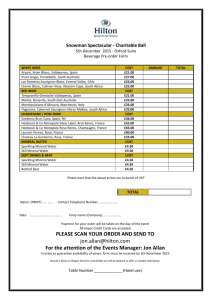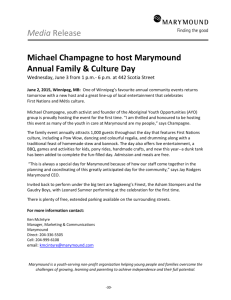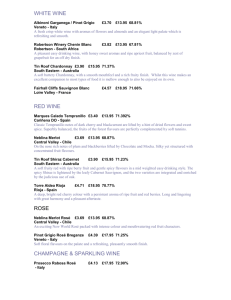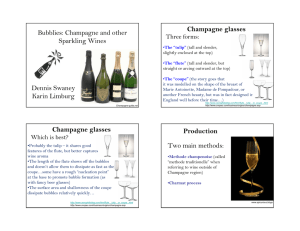It’s my Party: Influences upon Young Adults to Consume Sparkling
advertisement
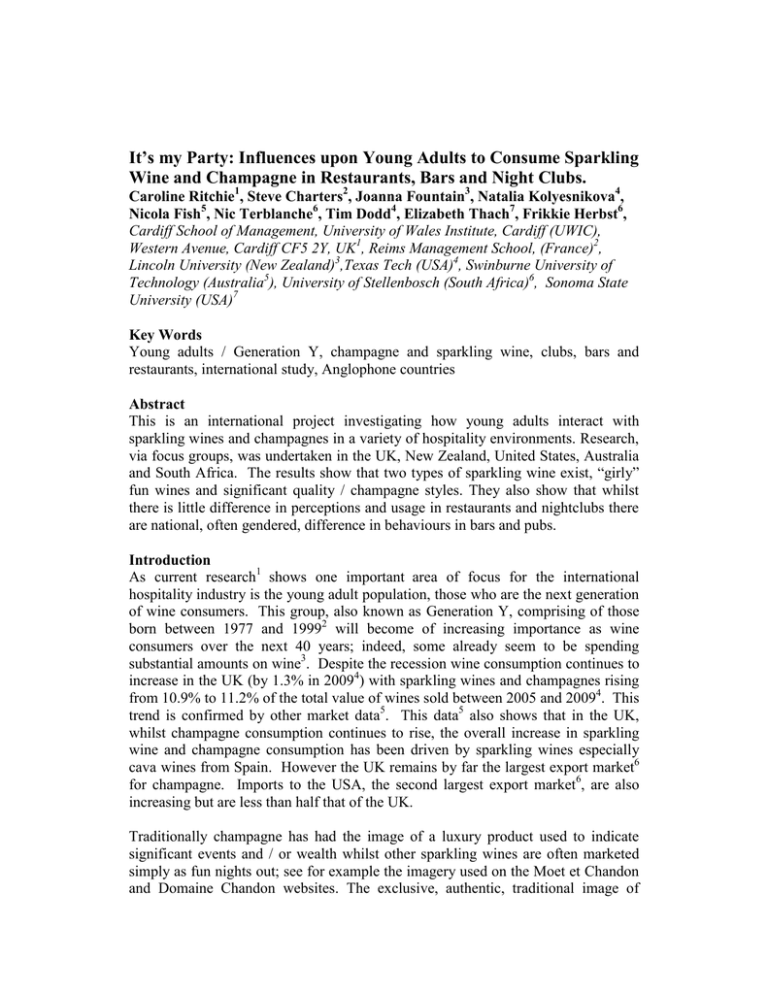
It’s my Party: Influences upon Young Adults to Consume Sparkling Wine and Champagne in Restaurants, Bars and Night Clubs. Caroline Ritchie1, Steve Charters2, Joanna Fountain3, Natalia Kolyesnikova4, Nicola Fish5, Nic Terblanche6, Tim Dodd4, Elizabeth Thach7, Frikkie Herbst6, Cardiff School of Management, University of Wales Institute, Cardiff (UWIC), Western Avenue, Cardiff CF5 2Y, UK1, Reims Management School, (France)2, Lincoln University (New Zealand)3,Texas Tech (USA)4, Swinburne University of Technology (Australia5), University of Stellenbosch (South Africa)6, Sonoma State University (USA)7 Key Words Young adults / Generation Y, champagne and sparkling wine, clubs, bars and restaurants, international study, Anglophone countries Abstract This is an international project investigating how young adults interact with sparkling wines and champagnes in a variety of hospitality environments. Research, via focus groups, was undertaken in the UK, New Zealand, United States, Australia and South Africa. The results show that two types of sparkling wine exist, “girly” fun wines and significant quality / champagne styles. They also show that whilst there is little difference in perceptions and usage in restaurants and nightclubs there are national, often gendered, difference in behaviours in bars and pubs. Introduction As current research1 shows one important area of focus for the international hospitality industry is the young adult population, those who are the next generation of wine consumers. This group, also known as Generation Y, comprising of those born between 1977 and 19992 will become of increasing importance as wine consumers over the next 40 years; indeed, some already seem to be spending substantial amounts on wine3. Despite the recession wine consumption continues to increase in the UK (by 1.3% in 20094) with sparkling wines and champagnes rising from 10.9% to 11.2% of the total value of wines sold between 2005 and 20094. This trend is confirmed by other market data5. This data5 also shows that in the UK, whilst champagne consumption continues to rise, the overall increase in sparkling wine and champagne consumption has been driven by sparkling wines especially cava wines from Spain. However the UK remains by far the largest export market6 for champagne. Imports to the USA, the second largest export market6, are also increasing but are less than half that of the UK. Traditionally champagne has had the image of a luxury product used to indicate significant events and / or wealth whilst other sparkling wines are often marketed simply as fun nights out; see for example the imagery used on the Moet et Chandon and Domaine Chandon websites. The exclusive, authentic, traditional image of champagne is an essential part of the rational for the price it commands7 and its importance at public socio/cultural gatherings such as weddings8. Attempts to „modernise‟ usage by producers7 and consumers9, such as drinking champagne with a straw from small bottles, often creates concern in relation to both debasing the image and accepted symbolic consumption behaviours. This is particularly true for moderately involved consumers whose habitual interaction with champagne is often a public demonstration of their personal capital8. However there is evidence10 which suggests that some young adults, particularly women, do not see wine with bubbles in it as wine but rather as a fun pleasurable alternative; an image which producers such as Domaine Chandon or Freixnet seek to promote in their marketing. Other research11 shows that young adults are particularly susceptible to such marketing images e.g. having fun with cool friends in places like pubs, clubs and restaurants. Often living in multiple occupancy or parental accommodation young adults tend to socialise outside the home. This should make them ideal consumers for the hospitality industry to attract and nurture as their next consumer generation. However young adults often have limited money and cost is a significant factor in their purchase of alcoholic beverages. As drinks in the on-trade are perceived to be expensive this may lead to significant preloading before a night out12 and reduced consumption in the on-trade: the average price of a bottle of champagne / sparkling wine in the UK off-trade is £11.58 (€13.50) and £40.01(€46.60) in the on-trade5. As table 1 shows this difference is not as wide in all of the countries studied but in all instances champagne is more expensive than other traditional method sparkling wines. Table 1. Average Bar, Nightclub and Restaurant Sparkling Wine / Champagne Prices Wine UK USA SA AUS NZ Bar; Sparkling Bar; Champagne Nightclub; Sparkling Nightclub; Champagne Restaurant; Sparkling Restaurant; own country traditional method Restaurant; Champagne £18-£25 / €21-€29 £35-£125/ €41-€145 £20-£60 /€35-€71 £40- £100 /€59-€118 £19 / €22 $18-$25 /€13-€18 $50-$70 /€37-€51 $30-$50 /€23-€37 $60-$105 /€44-€77 $25-$30/ €19 - €23 $40 - $60/ €30 - €46 R60 –R90 / €6 - €10 R400-R600 / €40-€60 R120–R180 /€12- €18 R900+/ €90+ $25-$70 /€18-€51 $120-$220 /€87-€160 $40-$80 /€29-€58 $150- $220 /€109-€160 $25 / €19 $50-$65 / €38 - €49 $30 - $46 /€17-€26 $99-$395 /€57-€226 $30 - $46 /€17-€26 $99-$395 /€57-€226 $45 - $50 /€26 - €29 $45 - $80 /€26 -€46 $60+ / €46+ R450-R650 / €45-€65 $80 -$130 / €60 -€98 $99 -$395 /€57-€226 N/A £30 - £45 /€35 - €47 R60 –R90 / €6 - €10 R120-R180 / €12-€18 However, resulting from the recession champagnes, albeit non- branded, have been sold in the off-trade in France for as little as €8.2513, which is less than the price of a quality, or even ordinary, sparkling wine in the on-trade (see table 1). Since the general quality and quantity of sparkling wines available is driving expenditure up this has the potential to lead to confusion in image / perception and so usage of both sparkling wines and champagnes. It also enhances the belief amongst young adults that champagne is very expensive in the on-trade in Anglophone countries. The aim of the full research project1 was to establish how young adults in differing Anglophone countries currently perceive and therefore interact with champagne and sparkling wines. This paper will identify behaviours in relation to public or on-trade usage, i.e. in pubs/bars, clubs and restaurants. Understanding how sparkling wines are seen and used by young adults may enable the hospitality industry to provide a more accurately tailored experience which consumers would want to buy into more often. Whilst accepting that pre-loading often impacts upon public drinking behaviours it is not the purpose of this paper to investigate private drinking habits. Methodology A summary of the methodology1 is presented for brevity. This was a cross-cultural examination of young adults‟ views and interactions with champagne and sparkling wine based in Anglophone countries (UK, New Zealand, United States, Australia and South Africa) for ease of transcription and data analysis. Focus groups were run in each country using a common focus group guide and eight identical pictures of champagne / sparkling wines to stimulate discussion. Additionally each focus group tasted three masked samples, a non-French sparkling wine, usually cava; a local traditional method sparkling wine (available in the off-trade in the UK); and a champagne widely available in that country. Initial comments were sought as well as comments when the wines were unmasked. There were one hundred and seventy four participants, 57% female and 43% male. All the focus groups were recorded, transcribed and coded for anonymity (using a common formula) by the moderator. They were then analysed via Nvivo8 by the project co-ordinator and again by the lead author of each emergent paper. Although the participants were young adults aged between 18 and 30 (21 to 30 in the USA) care was taken not to use predominantly student populations as this has the potential to bias results1,11,12. Results and Discussion The UK participants showed one particular difference from the other participants. This was their acute awareness of the difference between sparkling wine and champagne. This is likely to be for two reasons. Although there is a high quality traditional method sparkling wine industry in the UK it is tiny, recently developed and the wine is hard to source away from south-east England. Additionally the UK has a centuries long tradition of buying champagne from France. Cava, on the other hand, was introduced into the UK in significant amounts in the 1990‟s where its image is impacted by its significance as part of the general supermarket wine offering – i.e. often sold on promotion. In all other participating countries whilst cheap and cheerful sparkling wine is produced such as „Yellow‟ in Australia the terms sparkling wine and champagne were often used synonymously. However where champagne was used to describe a nationally produced sparkling wine a high quality traditional method wine / Cap Classique style was always meant. Thus all participants had a clear understanding that there is fun, fizzy, inexpensive wine and there is quality sparkling wine which is likely to be exclusive and expensive especially in the on-trade. Therefore the participants interacted with these two wine styles differently, some behaviours being common to all and others unique to particular cultures. Restaurant Cultures The results in this section divided into two distinct topics. In one participants talked about themselves as consumers, in the other many talked about their observations of others as they worked part-time in the hospitality industry. All participants talked about their image and so usage of sparkling wines and champagnes; champagne is for celebration, weddings, engagements, graduation and breakfasts7,8 etc. It is used to toast the event. However because it is used to toast the event champagne was seen as something to consume either as an aperitif or as suitable when ‘nibbles or platters of food are going round‟ (NZ3). No participants considered it to be a food wine (i.e. something to drink during a meal) and certainly not something they would order when having a meal. There were two reasons given for not ordering: one was cost (see table 1); the other, lack of knowledge/ confidence in buying11. Conversely, but not unexpectedly, there was agreement that if it was bought by others they would happily drink it. This behaviour, not buying but consumption, is reflected in other research15. Reflecting other work11 it suggests that in this age group the younger participants in particular lack the confidence and disposable income to eat out regularly in formal restaurant environments preferring cheaper cafes or pubs and drinking beer or spirits (individual purchase units) with their food. However they gain confidence and knowledge by the actions of „others‟ who provide the formal meal occasions which they do attend, usually parents or work, and thus they learn and replicate these cultures11,14. All the participants were 30 or under yet one Australian participant suggested that champagne made „you remember Breakfast at Tiffany’s‟(AUS1), a film made in 1961 well before any of these young consumers (and some of their parents) were born. References to champagne as a suitable drink for special breakfasts were frequently made in the Australian, USA and New Zealand focus groups. They pointed out a paradox; drinking champagne for breakfast was classy; beer or vodka would make you „like an alcoholic’ (AUS3). Participants from the USA, UK, New Zealand and Australia who had / worked in the hospitality industry commented upon the behaviour of others in relation to champagne at events such as weddings and celebrations. They suggested that whilst „champagne‟ had to be provided, especially at weddings, most people know very little about what they are drinking and that in the USA, Australia and New Zealand men might pick up a glass of bubbly for their female partners but get a beer for themselves. These participants suggested that the „champagne‟ might in fact be a simple sparkling wine such as Yellow (see previous discussion), poured out of public view and circulated on trays. They acknowledged that this was cheaper, but could also explain why, in the participants opinion, „champagne‟ at public events was often not worth drinking - unless someone else was paying. None queried the ethics of, potential deception involved, in this behaviour by hospitality industry management or hosts. Bar Cultures Consumption in pubs and bars had a far less unified image. There was general agreement that there are light bubbly, fruity, sparkling wines which are great especially for a girl‟s night, in or out, and then there is champagne / quality sparkling wine. However there was difference in when and where these could be consumed. The Australian, New Zealand and South African focus groups agreed that light and bubbly is for getting the party atmosphere going, especially for girls, but it could also be consumed on its own (NZ) or in cocktails (Aus, SA) in bars. In the UK light and bubbly was also seen as a girl‟s night out; additionally UK participants agreed that sometimes in mixed or male groups champagne might be bought, perhaps to celebrate, perhaps to show off. This could happen only in a bar not a pub; since the beer would be better it would be pretentious especially for men. The UK rationale was that in a small group one bottle would be bought and shared within the group and each round/ bottle could cost less than a round of conventional drinks. Buying, being seen to buy, rounds is of extreme importance in UK pub and bar culture once income permits11. USA participants suggested that sparkling wine/ champagne could be consumed in high end / city centre and cocktail bars, but not in college or sports bars. This view was driven by income and image rather than gender. Nightclub Cultures There was agreement that a bottle of champagne or sparkling wine was inappropriate in a night club if the participants wanted to dance; it would be impractical unless individual serves were available8 but these were seen as girly even if champagne. The idea of champagne being used primarily to pose rather than celebrate unlike in bars was discussed in all countries. There was agreement in South Africa and the UK that the wine would have to actually be champagne, „if you have a bottle of cava on the table, it’s not much, you’re not making a statement’ (UK3). Reference was made again in the UK to the fact that buying a bottle of champagne as a round is not necessarily that expensive when compared with other alcoholic drinks so if you are celebrating it can make financial sense. Female participants in New Zealand and the UK also discussed girls trying to get bottles of champagne / sparkling wine from DJ‟s or male customers as a challenge for the evening, presumably as a demonstration of attractiveness. Conclusion Not unexpectedly there was universal agreement that those sparkling wines seen as fun were “girly”, suitable for “girls nights in” or away from the home and that they could be successfully be used to create a party atmosphere. Quality sparkling wines / champagne had a much more serious image - the celebration of significant events – thus, usage was not gendered. Of interest is how these perceptions were learnt, perhaps via intergenerational socialisation and work mentoring14, and their universal connotations. Whilst behaviours in restaurants and nightclubs were generally universal, perceptions of acceptable behaviours in bars and pubs were not; interaction with sparkling wine in these environments was often gendered and proscribed. Further understanding of these behaviours might help the international hospitality industry to develop their product to meet the particular expectations of this generation. Finally, and unexpectedly, this research began to explore the impact of the casual work in restaurants, bars and nightclubs that many young adults undertake at some stage. This potentially exposes them to the best experiences but also some less good practice which, without prior knowledge and or experience, they accept to be the norm. This is likely to impact upon the future behaviour11. For example, those who saw and served Yellow as „champagne‟ are unlikely to be persuaded of the quality of the sparkling product at future events. However there is a huge difference in profit margin between beer and Yellow or Janz and Moet et Chandon. Therefore this is an area which managers of hospitality businesses should give serious attention to. References 1 Charters, S., Fountain, J., Kolyesnikova, N., Ritchie, C., Thach, E., Dodd, T., Fish, N., Herbst, F. and Terblanche, N. Generation Y and sparkling wines: A crosscultural perspective. International Journal of Wine Business Research. 2011 In Press 2 Lancaster, L. C., & Stillman, D. When Generations Collide: Who They Are. Why They Clash. How to Solve the Generational Puzzle at Work. New York: Harperbusiness 2003 3 Peskett, S. Under-30s are the big spenders in UK market. Harpers, 2006, 26th May: 10. 4 Key Note Wine: 2009 http://www.keynote.co.uk.ezproxy.uwic.ac.uk/marketintelligence/view/product/2309/chapter/4 (Accessed 11 December 2010) 5 WDR Wilson Drinks Report. www.wilson.drinks.report.com February 2010 6 Parkinson J. Fizz Stays Fresh. The Drinks Business. 2010;101 December: 32 -38 7 Beverland M. The ‟real thing‟: Branding Authenticity in the Luxury Wine Trade. Journal of Business Research 2006; 59: 251-258 8 Steichen, D., Terrien, C. A Model or Demand in a Repeated Purchase Situation: A Simulation of the Champagne Market. International Journal of Wine Business Research 2009; 21[4]: 354-372 9 Savage, M., Barlow, J., Dickens, P., Fielding, T. Culture, Consumption and Lifestyle. In Miller, D. editor. 2001. Consumption, Critical Concepts in the Social Sciences. (pp523 – 555) London Routledge, 2001 10 Thach, E., C., Olsen, J. Market Segmentation Analysis to Target Young Adult Wine Drinkers Agribusiness 2006; 22[3]: 307-322 11 Ritchie, C. Young Adult Interaction with Wine in the UK. International Journal of Contemporary Hospitality Management. 2011 In Press 12 Ritchie, C. Ritchie, F and Ward R. A Good Night Out: Alcohol-Related Behaviours in Young Adults. World Hospitality and Tourism Themes 2009; 1 [2]:169-193 13 Parkinson J. In a Fizz. The Drinks Business Champagne Report. 2010 pp14 -20 14 Ritchie, C. The Culture of Wine Buying Behaviour in the UK Off-Trade. International Journal of Wine Business Research.2009; 21 [3]: 194 – 211
